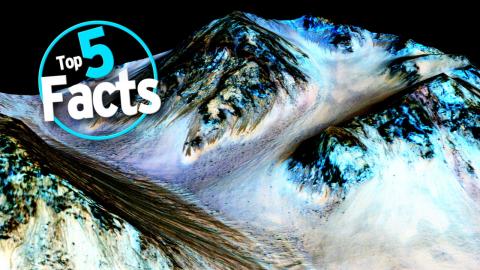Top 5 Far out Facts about Mars

Now that running water has been found on Mars (and how freaking cool is that?) we thought we'd share some other mind-bending facts about our space neighbour. Welcome to Watchmojo's Top 5 Facts. Today we're counting down our top five most far our facts about Mars, the red planet that's making headlines across the world.
Head over to http://www.WatchMojo.comsuggest to submit your ideas for the next edition of WM Facts
#5: Mars Has the Largest Dust Storms in the Solar System
In "The Martian" a giant dust storm that strands him on the planet. That's not just fiction– that's basically what a dust storm on Mars looks like. Mars whips up some truly intense dust storms, and most are so big that they can be seen from Earth using only a telescope. Once every three Mars years or so, the planet conjures up a global dust storm due to the radiative heat of the sunlight. These, as the name suggests, cover the entire planet and completely block out the sun, shrouding Mars in a terrifying and dirty darkness. It's probably when the aliens come out.
#4: In 2003, Mars Made its Closest Approach to Earth in 60,000 Years
Those of you alive in 2003, which we're assuming is a vast majority of you, can proudly claim that you lived through an important moment the history of astronomy. At 9:51 universal time on August 27, 2003, Mars came the closest to Earth it's been since the Neanderthals, at a you-can-almost-touch-it distance of this many light years! [Text on screen: “0.0000059192”] That’s about 56 million kilometers, or about 35 million miles. Okay, it doesn't sound very close, but that's almost nothing in terms of space distance, and those prone to hysteria even feared that Mars’s gravitational pull would yank Earth out of orbit, or make it tilt on its axis or something. However, the Sun is hundreds of times bigger than Mars and is normally closer to the Earth than Mars, and the Earth does just fine. So, as all of you over the age of 12 can attest, nothing catastrophic happened.
#3: It Houses the Tallest Peak in the Entire Solar System
Not only is Mars champion of the dust storms, but it also has the distinction of having the tallest peak in the entire solar system. Olympus Mons, which is a volcano, is so high and flat that someone could literally be standing on it without realizing it due to a combination of its immense size and the curvature of the planet. is more than double the height of Mount Everest and rises roughly fifteen miles, or 24 kilometres, above the mean surface level of Mars. It’s got a cliff face that is 8 kilometres (or 5 miles) high– imagine standing at the base of that. It covers roughly 300,000 square kilometres, or– know what? Can I just make a request that once we move to Mars, we use only miles or kilometres. K, thanks.
#2: Pieces of Mars Have Fallen to Earth
Every once in a while, a small meteorite might fall from space and land in some farmer's field, making for a nice keepsake. And other times they're freakin' pieces that have fallen off of Mars! There have been at least five recorded occasions of people recovering pieces of Martian rock, likely blasted off by an asteroid strike, with the most recent falling in the Moroccan desert. Two hundred and twenty pounds of Martian rock are known to exist on Earth, and each piece goes for about 10x the price of gold due to their immense rarity and the value they hold to scientists, who like to study the hell out of them.
#1: Lichens and Bacteria Can Also Survive on Mars
In the ever-important research of space colonization, scientists have begun to dabble in ideas regarding terraforming Mars. Researchers at the German Aerospace Center simulated a Martian environment and discovered that lichens and bacteria continued to thrive in the conditions, a huge step for theorizing the possibility of life on Mars. Even though terraforming Mars likely won't happen for thousands of years, scientists have already devised various methods. These include large mirrors that will reflect sunlight onto the surface, or smashing ammonia-heavy asteroids (if we can find any) into the planet to raise greenhouse gas levels. It’s an exciting time to be alive! Just, not on Mars.
So what do you think of our space neighbour? Would your be interested in signing up for a manned mission? For more 10-times-the-price-of-gold top tens and ammonia-heavy top fives, be sure to subscribe to Watchmojo.com.


